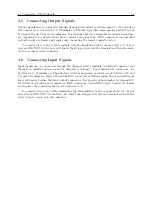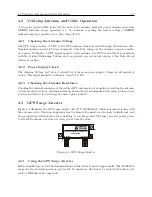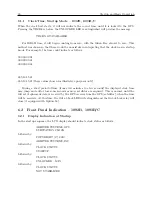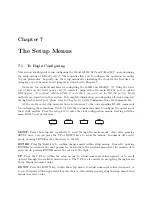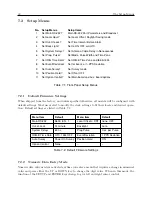
4.4 Technical Details on GPS Antennas and Cables
19
DC Resistance
The cross-sectional area and length of the conductors in the cable determine the dc resistance.
Since power to the RF preamplifier in the antenna is supplied via the antenna cable, excessive dc
resistance will degrade performance.
Because of the above factors, changes to the length and/or type of antenna cable should be
made carefully. Damaged cables may also affect performance.
Available Antenna Cables and Accessories for Longer Runs
Arbiter Systems offers longer antenna cables for use with all models of clocks when the standard
15-meter (50-foot) cable is inadequate. For RG-6 cable runs greater than 250 feet, up to 500 feet,
Arbiter offers a 21-dB in-line amplifier, P/N AS0044700. A larger RG-11 style cable is available
(P/N WC0004900, 305-m / 1000-ft roll), that can be used for runs to 120 meters (400 feet) without
the in-line preamplifier, or 240 meters (800 feet) with the AS0044700 amplifier. See a list of these
accessories in Table 4.2.
P/N
Description
Delay, ns
Signal Level, dB
CA0021315
15-m (50-ft) cable, RG-6
60 ns
-5 dB
CA0021330
30-m (100-ft) cable, RG-6
119 ns
-9 dB
CA0021345
45-m (150-ft) cable, RG-6
177 ns
-13 dB
CA0021360
60-m (200-ft) cable, RG-6
236 ns
-17 dB
CA0021375
75-m (250-ft) cable, RG-6
295 ns
-21 dB
WC0004900
305-m (1000-ft) roll RG-11
3.92 ns/m
-17.5 dB/100 m
AS0044800
RG-11 crimp tool and 25 connectors
N/A
N/A
AS0044700
21-dB in-line amplifier
1 ns
+21 dB
Table 4.2: GPS Cable Data and Accessory Information
Physical Protection
When routing the antenna cable, protect it from physical damage, which may result from closing
doors, falling objects, foot traffic, etc. Also, when routing around corners, allow for sufficient bend
radius to prevent kinks. Extra length should be allowed at both ends of the cable to prevent tension
on the connectors, which could cause damage or failure. Extra length is useful as a service loop, in
the event that a connector needs replacement.
Do not stretch the cable mid-air over any appreciable distance without support. Cable degra-
dation or failure could result. Always leave a drip loop wherever the cable enters a structure, to
prevent water from entering the structure via the cable jacket. The maximum temperature rating
for the type of cable provided with the clock is 75
◦
C (167
◦
F). Exercise care when routing the cable
near sources of heat to avoid cable damage.
Summary of Contents for 1092A
Page 4: ...iv ...
Page 18: ...xviii LIST OF TABLES ...
Page 129: ...C 10 Option 20A Four Fiber Optic Outputs 111 Figure C 7 Option 20A Jumper Locations ...
Page 131: ...C 11 Option 27 8 Channel High Drive 113 Figure C 8 Option 27 Jumper Locations ...
Page 148: ...130 Options List Figure C 10 Option 29 Connector Signal Locations ...









